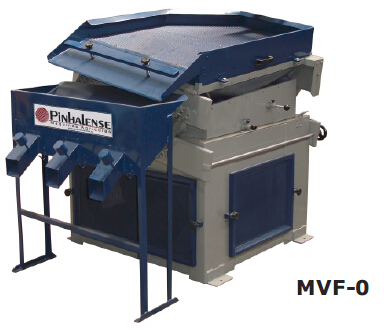Coffee At Your Side - Coffee monthly newsletter section 85
The new coffee berry borer pesticide approved
Brazilian Federal Government Gazette published a decree to determine the coffee fruit beetle pest containment procedures to be followed. A main component of the low toxicity of pesticides Ciantraniliprole will be used. This insecticide has been World Health Organization and the United Nations Food and Agriculture Organization (FAO) approved and registered in the United States, the EU, Japan and Canada. Brazil is expected at the end of the registration of the pesticide, and the Secretary-General considers that the protection of agricultural pesticides Once approved, the next harvest season, it can control the coffee berry borer imminent threat brought.
Inventories remain high export volume of coffee
According to the Brazilian Coffee Exporters Association Cecafé statistics, 2014 Brazilian coffee exports should reach 33.5 million bags, up 6.5 percent over 2013. This result may be due to the consumption of inventory, because of the weather causes widespread current coffee crop production. The past six months, the Brazilian coffee exports has been high, reached a total of 17.5 million bags. Taking into account the domestic consumption will consume an additional 20 million bags and 2014 production should be less than 48 million bags, CeCafé think coffee stocks early in 2015 will decline.
Dispute over imports of raw beans
An evaluation of imports from Vietnam to achieve Robusta coffee blending technical analysis has been completed. Although the study by the Brazilian instant powder industry required at least indicate a possible disease (raw beans often found a man named khapra beetle insects) for national production is a hazard for the release of students beans imported controversy - is called "rebate", suffered a strong Brazilian growers boycott. Party debate is the Brazilian Coffee Roasters Association (ABIC) and the Brazilian instant coffee industry federation (ABICS), they think that the import is to enhance industrial competitiveness, improve the export of instant coffee, coffee acts as a way to cut production period alternatives. While Brazil currently has one of the world's largest robusta producer, but their Robusta and Arabica blending largely used in commercial roasted beans and roasted pink brand among, but also exported in large quantities, which enables instant powder industry left little raw, so the price is high. On behalf of the other argument is based coffee growers and cooperatives, they are mainly opposed to the tax rebate mechanism, fearing that could threaten national production of Robusta. The debate on the topic has been discussed many times in the official meetings, debates personnel from the Brazilian coffee growing areas, and the short period of time can not arrive at a result.
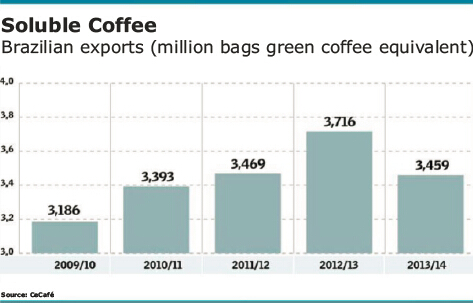
Technology can help growers reduce harvesting costs
Minas Gerais Paraiso Sao Sebastiao for members of a coffee cooperative has developed a large mechanical harvesters lease system. In Brazil, rising labor costs and labor resources are scarce escalating situation, machinery can help growers save up to 50% of the harvest costs. The average rental cost per hour is 240 harvesters such Lille ($ 104), but the price is a cooperative project group given 180 per hour Lille ($ 78). Growers want to lease the machine will help the technical staff to assess the suitability of the terrain make good use of harvesters. The cooperative has 32 sets of mechanical harvesters, able to serve 800 coffee producers.
Espirito Santo developed a new high-yielding varieties of Connie Long
Espirito Santo Incaper institute responsible for research and rural extension has been agreed to protect the right Coney Dragon 3 new varieties, namely Diamante models ES8112 (Diamante ES8112), Centennial models ES8132 (Centenária ES8132) and Jequitibá ES8122. The institute spent 12 years to develop new varieties of these three models, each one composed by nine clones and represents a high-yield and high quality. This is similar to the protection of rights and patents, which means anyone who wants to commercialize, copy or use of these varieties are required and Incaper establish cooperative relations, the good news is not required to pay any compensation, because the institute is willing to give up to obtain patent fees that power. Variety Protection Act, enacted in 1997 by the Ministry of Agriculture, in order to protect those who are considered innovative new varieties, homogeneous and stable invention. This is a security measure, because once protected, the species will be able to register for future genetic instructions and detect illegal goods.
Research coffee ringspot virus to be completed in 2014
Study on coffee ringspot virus by Musharraf Las Federal University and University of Kentucky's cooperation, its findings - a complete series of the virus genome is stored in the National Biotechnology Information Center. Basic research began in 2001, and the results serve as input genome series began to study the series began in 2011 and concluded in the year. Many research contributions we can tell, for example, a packet correctly, a broad knowledge to the development of new and better resistance to the transgenic plants and recommended effective means to control the virus.
Bahia became the southern end of Robusta production centers
With eucalyptus and cocoa famous Bahia Narayanan straighten gradually become Connie Long (Robusta) is an important production center. This progress is mainly in the production season 2014/15 be noticed - production is expected to reach one million bags (60kg / bag), compared to five years ago, production is only 400,000 bags. Part of the reason is due to the success of the district powerful climate, regular rainfall and the recent strong price incentives Connie Long a grower. On the other hand, Minas Gerais - Brazil's largest Arabica production areas, 2014/15 production season is expected to yield 22,992 one million bags, have begun to bear Connie Long production, but only the state output 1%.
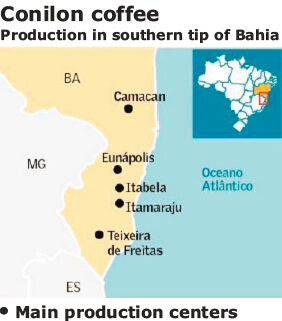
Espirito Santo coffee cooperatives exports to Cuba 45,000 bags robusta
This year, located in Espirito Santo Santa Maria de Jetibá region Coopeavi cooperatives to Cuba exported 45,000 bags of Connie Long, worth $ 55 million. This is the second consecutive year the cooperative coffee exports to Cuba, and 200 families produced for export total of seven varieties Connie Long, and was recognized as a high quality coffee. In Cuba, the coffee will be processed and used for basic government demand goods package / box. Coopeavi has about 5,600 coffee growers, coffee exports in 2013 23,700 bags (60kg / bag), 2012 exports of 3,800 bags.
Brazil Specialty Coffee Association and the Specialty Coffee Association of Europe to establish a direct link
Specialty Coffee Association of Europe (SCAE) recently joined Brazil Specialty Coffee Association (BSCA) to become its members. Its purpose is to Europe's premier specialty coffee companies and Brazil Specialty Coffee Association to establish direct contact, therefore, in addition to the promotion of national promotion policy, will also improve the SCAE member units: such as national producers, importers, roasters and coffee shops linkages between. According to the introduction of Brazil Specialty Coffee Association executive director of the Association two years ago began to deepen the relationship between them, the goal is to promote training in international affairs, vocational training and qualification training, special discounts and joint action among members of informal relationship.
Brazil capsule coffee market
Although Brazil has the world's second-largest coffee consumer market, but represents only one percent of coffee capsules Brazilian family sales. Nestle espresso coffee (Nespresso) Global CEO estimates that this data will rise to 20% in a very long time, with the same mature markets. Nestle espresso coffee (Nespresso) is designed to allow consumers to begin to taste like coffee, like wine tasting, tasting its origin, flavor and aroma. Currently, Brazil has become Nestle espresso (Nespresso) product, one of the country's top ten procurement. Nestle Group Purchasing beans from 2.2 Brazilian growers, coffee capsules sold by 70% of raw materials from Brazil.
The effects of drought and damage to the Brazilian coffee growing regions: Updated version
This article is the fourth year outlook coffee electronic monthly edition of the part to be updated, along with the original for your reference. Although the true extent of the damage is not completely known - massive shelling process has now started - it is worth mentioning three new factors are: Arabica production forecast is reduced, Brazilian coffee exports higher in 2014 and coffee trees affected by the recent rains early flowering.
Arabica VS total estimated
Yield the right chart 明阿拉比卡 estimates the total amount of the difference between the market is not big tips. By Procafé (a research institute, a member of the Brazilian Agricultural Research Corporation under the management of the Brazilian coffee Embrapa Research Institute), CONAB (Agriculture Bureau, responsible for warehouse and production forecast) and the USDA (United States Department of Agriculture) were made by three differences on Robusta (Connie Long) total estimated data is very large, but the estimated amount of the difference between Arabica small. Connie Long highest estimated amount higher than the minimum estimated amount of 37%, while only 11% of Arabica. So are these data should not be regarded as a slight lead Arabica market fluctuations and price stability table behavior? The fact has always been different, Arabica and Robusta play a lot of alternative products and markets. The result is a class of coffee availability or lack of will in some way interfere with the prices of other products, which is why the independent analysis of the market price of Arabica and Robusta meaningless reasons. Arbitrage - the price difference between the two kinds of coffee - is being permanently scrutiny roasters and instant powder manufacturers, when they make a purchase and blending decisions. In summary, the broad range of Brazilian coffee production estimated value created Arabica market volatility, which has nothing to do with the fact - that the three estimates of growth seems to be consistent with the size of Arabica production, as the chart three estimates implies.
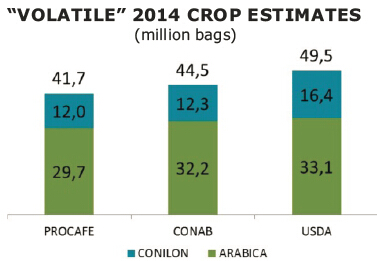
High Brazilian coffee exports
2014 a large number of export and record data year may not deceive Brazilian coffee market analyst. Inventory of heavy use, and can not be supplemented with current production of coffee stocks are supporting these high export volume. If the average person spend in the chart's total --4,500 million bags, minus the domestic consumption of 21 million bags and 3.5 million bags of instant flour mill demand, leaving 20.5 million bags - third of current production the two can be seen for export ...... from the remaining inventory will not much. If only the production of Arabica analysis, then the deficit will be very serious, and yield losses do exist.
Stock plus the early rapid recovery supported exports caused a false impression of a coffee production - seems to have disappeared cuts. Arabica coffee harvest is indeed a lot of new, fast complement cooperatives and roasters warehouse harvest was affected by the impact of hot weather in advance. However, this rhythm but can not be sustained, because the end time harvest of small quantities of coffee earlier than usual.
Early flowering
By the end of July early August rainfall caused coffee trees in some areas early flowering. In the absence of further sustained rainfall, these flowers will not develop into a coffee fruit - August is unlikely to rainfall, making incremental part of the potential production in 2015 has been doomed to disappear.
The last few months before the full flowering of coffee, intense rain occurred in the coffee-growing region of excessive rainfall and rain slapping phenomenon may lead to a further decline in 2015 coffee production. Overall, Brazil had to start thinking seriously slow climate change. Irrigation is probably the easiest, but not necessarily the cheapest or the most sustainable solution because it does not take into account the high temperature anomaly - which has resulted in this year's coffee black irrigation district - an excessive amount of ultraviolet radiation, early flowering is not results, and similar problems. For this task can be a lot of research, but also the will of practical recommendations to growers into the time.
The effects of drought and loss of Brazilian coffee
Undoubtedly, many important coffee growing areas in Brazil suffered a severe drought, an excess of infrared radiation and unusual high temperatures occur in the critical period of the coffee tree results as a result, coffee production 2014 production season will be affected by the loss. Due to various reasons, the same phenomenon is likely to affect the output of 2015. However, both the real damage to the amount of the production season in doubt.
The root cause is not difficult to understand for anyone yield loss: lack of moisture inhibits the formation of the fruit, the result is coffee beans smaller, lighter, or did not grow coffee beans; temperature and radiation affects photosynthesis and fruit formation and growth in 2015 is about to fruiting branches; finally, but equally important is the high temperature helps to pests, such as fruit borers and worms multiply.
Loss for the upcoming production of coffee is estimated mainly concentrated in poor quality fruit formation, assessment methods for floating fruit of the coffee-producing areas in particular, measuring the number and / or anatomical fruit, testing the quality of coffee beans forming stage, usually these areas have suffered as a phenomenon as described above and experience. One concern, the impact of drought and high temperatures on the Brazilian coffee growing areas are not exactly the same. Focus Second, how to evaluate the origin of "sample" of the validity and samples on behalf of their "master" in the various areas of Brazil, after the expansion of latitude, that is the equivalent of from northern Ecuador to southern Mexico, across Colombia and throughout Central America areas. Three concerns, often amplified yield losses tend to follow man-made and natural disasters, like the Central American leaf rust outbreak, losses occur immediately. However, to be fair, these factors are true - high temperature, radiation and drought - never occur simultaneously to this, but also affect the development of the coffee tree yields and branches.
Resulting in estimates in the current situation would be the real cause of yield loss is visible so difficult to bear fruit, and no usual size, the weight of the beans, and there may simply not bear the commercial value of coffee beans. As a device manufacturer, experience tells us that even after the coffee harvest, fruit volume seen, but the loss can not be fully assessed. Loss only after the shelling in order to truly know, when the removal of the coffee-meter enclosure and effective that coffee meters in size and weight. "Shelling loss" will be higher than usual, which is typical result of drought.
In this case, the assessment of production in 2015 will be more complicated because they need to assess the damage to the root system, they may affect the flower buds of variation, and can be seen in March and April 2015, the growth of this and branches different, through the branches, "festival" measured. Further, even in the best case, the original rhythm returned rainfall, lack of moisture in the rainy season before the next still occur to those described above for the impact Arabica cultivation conditions and the results of the capacity against the coffee tree.
The purpose of this paper is not to say the loss is small, on the contrary, the loss of some of the region is real, but be careful not to promote it to all coffee producing areas. The market has started to receive such information, and now is likely to be unsuitable for reducing excessive losses. On the other hand, now that happens this year is a new climate models "Preview" as well as future potential production in Brazil affected premature.
Weather experts say the drought in 2014 has now been proved neither the greenhouse effect is not caused by climate change, the cycle can be seen as an event. Coffee expert added: lack of rainfall and high temperatures, even in this new climate pattern appears, you can also do a lot to maintain coffee production in Brazil, they can respond better to carry out farming - good agricultural practices sustainability - from the beginning to the shade of irrigation, including the development of coffee varieties to adapt to new weather patterns.
* Eduardo Sampaio is UTZ certified by the representative of Brazil
Can create opportunities to increase the value of dried fruit shelling machine and small grader
With domestic consumption of coffee in the coffee producing developing countries, the use of dried fruit shelling machine is no longer confined to the processing of natural law Arabica and Robusta growers. On the one hand, emerging markets, coffee producing countries require different materials, including natural law, including coffee, even in the traditional washed Arabica producing countries as well. On the other hand, with the decline in the selective harvesting of fruit, all coffee producing countries tend to produce more natural method of coffee and looking for sales in the market, especially in the coffee producing countries market. Finally, with respect to the washed Arabica counterparts, the natural Arabica rarely market regulation, which created a specific business opportunities. In short, in many if not all of the coffee-producing countries, shelling capacity of natural dried coffee fruit has become a concern of the industry and increase the value of coffee a unique opportunity.
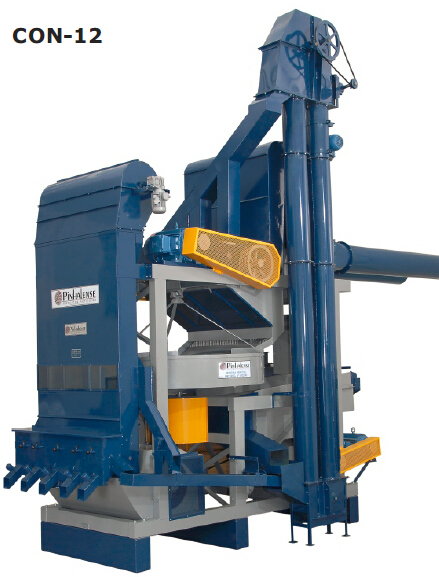
Pinhalense many years ago recognized this trend and make a sales record of producing dried fruit shelling machine washed Arabica perfect in every country, but also includes a strong sales record natural Arabica and Robusta producing countries . Pinhalense go stone, shelling, sorting combination machine (CON series) has now been used in the vast majority of coffee-producing countries and is independent of the coffee plant varieties.
CON series portfolio shelling machine includes a pre-cleaning machine independent structure (alternative), a fluidized bed in addition to stone, a built-in separation and recycling system and an integrated cold shelling machine, which can be processed separately small particles and large particles shelled beans. CON unique concept and design makes it possible to increase the maximum 2% of the shelling yield, and shelling machine friction compared to traditional hot words. In addition, the CON processed coffee beans can be sold directly to roasters and no need for further processing. If you need to export quality coffee beans, CON can be subsequent fractioning or gravity separation processing based on the quality of dried fruit inputs.
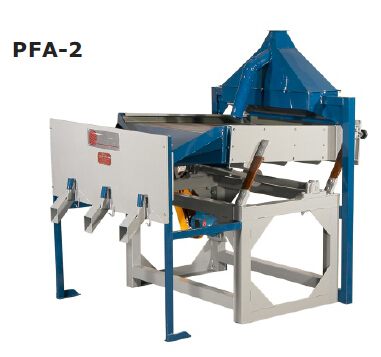
Beans processing capacity of current alternative CON combination shelling machine from 600 kg to 1.8 tons per hour, ranging from sub-standing type and mobile type, which is mounted on a truck bed or trailer, driven by a diesel engine and clutch. There is a low capacity (300 kg / h) Jane matching C2DPRC for your choice, it can be divided into three integrated particle size grading machine functions.
Pinhalense cold shelling machine described above can be used for processing of shelled beans, because there are advantages to avoid overheating shelling shelling and increase production, in fact, they have also been used to shell the beans processed in many countries. If it is necessary to remove the silver skin, in the same rack CON shelling machine can also install or not install special polishing machine. Small shelling machine C2DPRC has built polishing machine.
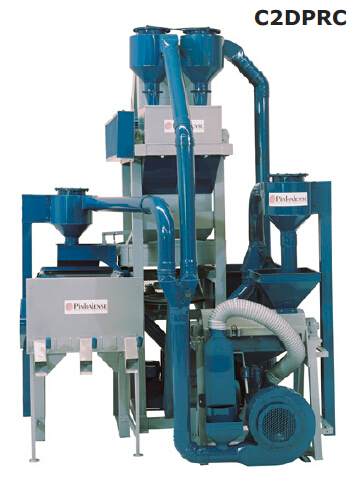
After the above process sheller can install small diameter PFA or PI grader, and gravity sorter MVF. These devices can be classified according to size fractionation of coffee beans, and to remove the shell is lower than the density of the low quality of coffee beans, this aim, as mentioned earlier - in preparation for the baking or for export.

 Espirito Santo coffee cooperatives exports to Cuba 45,000 bags robustaThis year, located in Espirito Santo Santa Maria de Jetibá region Coopeavi cooperatives to Cuba exported 45,000 bags of Connie Long, worth $ 55 million. This is the second consecutive year the cooperative coffee exports to Cuba, and 200 families produced for export total of seven varieties Connie Long, and was recognized as a high quality coffee. In Cuba, the coffee will be processed and used for basic government demand goods package / box. Coopeavi has about 5,600 coffee growers, coffee exports in 2013 23,700 bags (60kg / bag), 2012 exports of 3,800 bags.Brazil Specialty Coffee Association and the Specialty Coffee Association of Europe to establish a direct linkSpecialty Coffee Association of Europe (SCAE) recently joined Brazil Specialty Coffee Association (BSCA) to become its members. Its purpose is to Europe's premier specialty coffee companies and Brazil Specialty Coffee Association to establish direct contact, therefore, in addition to the promotion of national promotion policy, will also improve the SCAE member units: such as national producers, importers, roasters and coffee shops linkages between. According to the introduction of Brazil Specialty Coffee Association executive director of the Association two years ago began to deepen the relationship between them, the goal is to promote training in international affairs, vocational training and qualification training, special discounts and joint action among members of informal relationship.Brazil capsule coffee marketAlthough Brazil has the world's second-largest coffee consumer market, but represents only one percent of coffee capsules Brazilian family sales. Nestle espresso coffee (Nespresso) Global CEO estimates that this data will rise to 20% in a very long time, with the same mature markets. Nestle espresso coffee (Nespresso) is designed to allow consumers to begin to taste like coffee, like wine tasting, tasting its origin, flavor and aroma. Currently, Brazil has become Nestle espresso (Nespresso) product, one of the country's top ten procurement. Nestle Group Purchasing beans from 2.2 Brazilian growers, coffee capsules sold by 70% of raw materials from Brazil.The effects of drought and damage to the Brazilian coffee growing regions: Updated versionThis article is the fourth year outlook coffee electronic monthly edition of the part to be updated, along with the original for your reference. Although the true extent of the damage is not completely known - massive shelling process has now started - it is worth mentioning three new factors are: Arabica production forecast is reduced, Brazilian coffee exports higher in 2014 and coffee trees affected by the recent rains early flowering.Arabica VS total estimatedYield the right chart 明阿拉比卡 estimates the total amount of the difference between the market is not big tips. By Procafé (a research institute, a member of the Brazilian Agricultural Research Corporation under the management of the Brazilian coffee Embrapa Research Institute), CONAB (Agriculture Bureau, responsible for warehouse and production forecast) and the USDA (United States Department of Agriculture) were made by three differences on Robusta (Connie Long) total estimated data is very large, but the estimated amount of the difference between Arabica small. Connie Long highest estimated amount higher than the minimum estimated amount of 37%, while only 11% of Arabica. So are these data should not be regarded as a slight lead Arabica market fluctuations and price stability table behavior? The fact has always been different, Arabica and Robusta play a lot of alternative products and markets. The result is a class of coffee availability or lack of will in some way interfere with the prices of other products, which is why the independent analysis of the market price of Arabica and Robusta meaningless reasons. Arbitrage - the price difference between the two kinds of coffee - is being permanently scrutiny roasters and instant powder manufacturers, when they make a purchase and blending decisions. In summary, the broad range of Brazilian coffee production estimated value created Arabica market volatility, which has nothing to do with the fact - that the three estimates of growth seems to be consistent with the size of Arabica production, as the chart three estimates implies.
Espirito Santo coffee cooperatives exports to Cuba 45,000 bags robustaThis year, located in Espirito Santo Santa Maria de Jetibá region Coopeavi cooperatives to Cuba exported 45,000 bags of Connie Long, worth $ 55 million. This is the second consecutive year the cooperative coffee exports to Cuba, and 200 families produced for export total of seven varieties Connie Long, and was recognized as a high quality coffee. In Cuba, the coffee will be processed and used for basic government demand goods package / box. Coopeavi has about 5,600 coffee growers, coffee exports in 2013 23,700 bags (60kg / bag), 2012 exports of 3,800 bags.Brazil Specialty Coffee Association and the Specialty Coffee Association of Europe to establish a direct linkSpecialty Coffee Association of Europe (SCAE) recently joined Brazil Specialty Coffee Association (BSCA) to become its members. Its purpose is to Europe's premier specialty coffee companies and Brazil Specialty Coffee Association to establish direct contact, therefore, in addition to the promotion of national promotion policy, will also improve the SCAE member units: such as national producers, importers, roasters and coffee shops linkages between. According to the introduction of Brazil Specialty Coffee Association executive director of the Association two years ago began to deepen the relationship between them, the goal is to promote training in international affairs, vocational training and qualification training, special discounts and joint action among members of informal relationship.Brazil capsule coffee marketAlthough Brazil has the world's second-largest coffee consumer market, but represents only one percent of coffee capsules Brazilian family sales. Nestle espresso coffee (Nespresso) Global CEO estimates that this data will rise to 20% in a very long time, with the same mature markets. Nestle espresso coffee (Nespresso) is designed to allow consumers to begin to taste like coffee, like wine tasting, tasting its origin, flavor and aroma. Currently, Brazil has become Nestle espresso (Nespresso) product, one of the country's top ten procurement. Nestle Group Purchasing beans from 2.2 Brazilian growers, coffee capsules sold by 70% of raw materials from Brazil.The effects of drought and damage to the Brazilian coffee growing regions: Updated versionThis article is the fourth year outlook coffee electronic monthly edition of the part to be updated, along with the original for your reference. Although the true extent of the damage is not completely known - massive shelling process has now started - it is worth mentioning three new factors are: Arabica production forecast is reduced, Brazilian coffee exports higher in 2014 and coffee trees affected by the recent rains early flowering.Arabica VS total estimatedYield the right chart 明阿拉比卡 estimates the total amount of the difference between the market is not big tips. By Procafé (a research institute, a member of the Brazilian Agricultural Research Corporation under the management of the Brazilian coffee Embrapa Research Institute), CONAB (Agriculture Bureau, responsible for warehouse and production forecast) and the USDA (United States Department of Agriculture) were made by three differences on Robusta (Connie Long) total estimated data is very large, but the estimated amount of the difference between Arabica small. Connie Long highest estimated amount higher than the minimum estimated amount of 37%, while only 11% of Arabica. So are these data should not be regarded as a slight lead Arabica market fluctuations and price stability table behavior? The fact has always been different, Arabica and Robusta play a lot of alternative products and markets. The result is a class of coffee availability or lack of will in some way interfere with the prices of other products, which is why the independent analysis of the market price of Arabica and Robusta meaningless reasons. Arbitrage - the price difference between the two kinds of coffee - is being permanently scrutiny roasters and instant powder manufacturers, when they make a purchase and blending decisions. In summary, the broad range of Brazilian coffee production estimated value created Arabica market volatility, which has nothing to do with the fact - that the three estimates of growth seems to be consistent with the size of Arabica production, as the chart three estimates implies.
 Pinhalense many years ago recognized this trend and make a sales record of producing dried fruit shelling machine washed Arabica perfect in every country, but also includes a strong sales record natural Arabica and Robusta producing countries . Pinhalense go stone, shelling, sorting combination machine (CON series) has now been used in the vast majority of coffee-producing countries and is independent of the coffee plant varieties.CON series portfolio shelling machine includes a pre-cleaning machine independent structure (alternative), a fluidized bed in addition to stone, a built-in separation and recycling system and an integrated cold shelling machine, which can be processed separately small particles and large particles shelled beans. CON unique concept and design makes it possible to increase the maximum 2% of the shelling yield, and shelling machine friction compared to traditional hot words. In addition, the CON processed coffee beans can be sold directly to roasters and no need for further processing. If you need to export quality coffee beans, CON can be subsequent fractioning or gravity separation processing based on the quality of dried fruit inputs.
Pinhalense many years ago recognized this trend and make a sales record of producing dried fruit shelling machine washed Arabica perfect in every country, but also includes a strong sales record natural Arabica and Robusta producing countries . Pinhalense go stone, shelling, sorting combination machine (CON series) has now been used in the vast majority of coffee-producing countries and is independent of the coffee plant varieties.CON series portfolio shelling machine includes a pre-cleaning machine independent structure (alternative), a fluidized bed in addition to stone, a built-in separation and recycling system and an integrated cold shelling machine, which can be processed separately small particles and large particles shelled beans. CON unique concept and design makes it possible to increase the maximum 2% of the shelling yield, and shelling machine friction compared to traditional hot words. In addition, the CON processed coffee beans can be sold directly to roasters and no need for further processing. If you need to export quality coffee beans, CON can be subsequent fractioning or gravity separation processing based on the quality of dried fruit inputs. Beans processing capacity of current alternative CON combination shelling machine from 600 kg to 1.8 tons per hour, ranging from sub-standing type and mobile type, which is mounted on a truck bed or trailer, driven by a diesel engine and clutch. There is a low capacity (300 kg / h) Jane matching C2DPRC for your choice, it can be divided into three integrated particle size grading machine functions.Pinhalense cold shelling machine described above can be used for processing of shelled beans, because there are advantages to avoid overheating shelling shelling and increase production, in fact, they have also been used to shell the beans processed in many countries. If it is necessary to remove the silver skin, in the same rack CON shelling machine can also install or not install special polishing machine. Small shelling machine C2DPRC has built polishing machine.
Beans processing capacity of current alternative CON combination shelling machine from 600 kg to 1.8 tons per hour, ranging from sub-standing type and mobile type, which is mounted on a truck bed or trailer, driven by a diesel engine and clutch. There is a low capacity (300 kg / h) Jane matching C2DPRC for your choice, it can be divided into three integrated particle size grading machine functions.Pinhalense cold shelling machine described above can be used for processing of shelled beans, because there are advantages to avoid overheating shelling shelling and increase production, in fact, they have also been used to shell the beans processed in many countries. If it is necessary to remove the silver skin, in the same rack CON shelling machine can also install or not install special polishing machine. Small shelling machine C2DPRC has built polishing machine.
